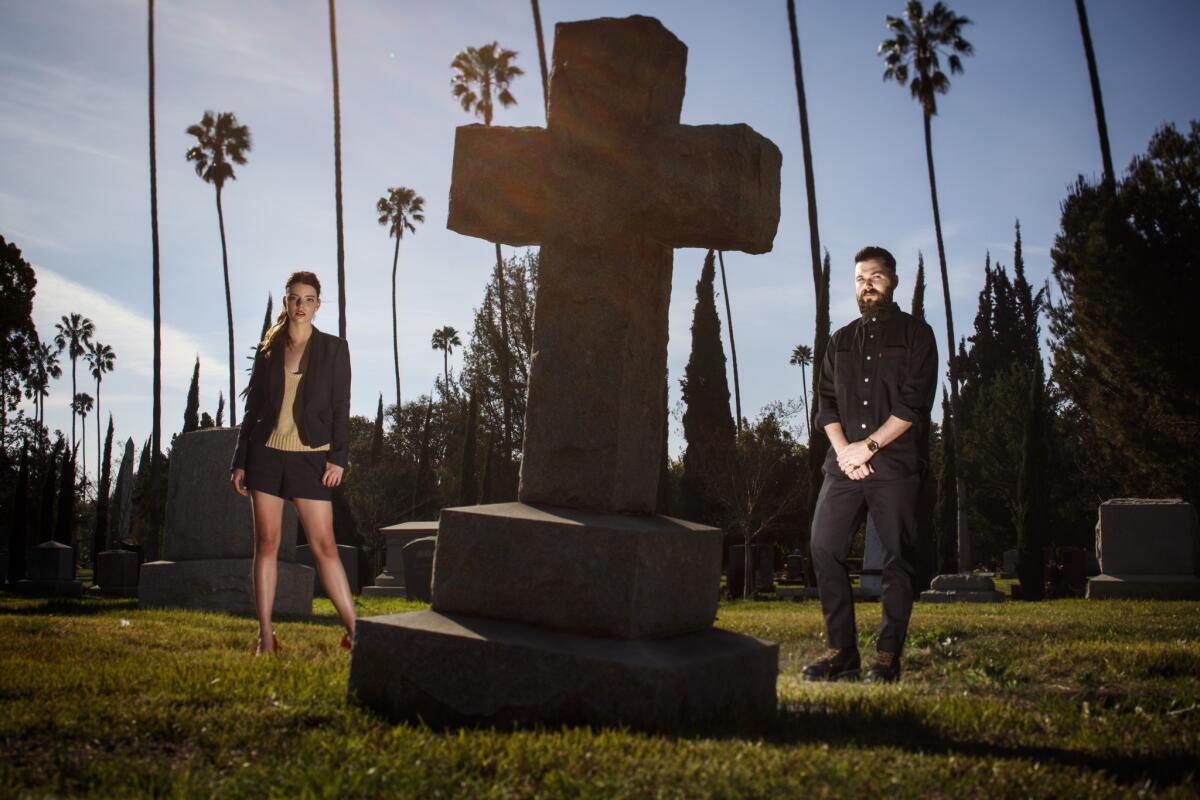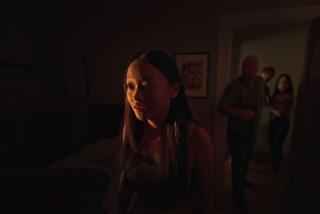Indie Focus: Visionary journeys with ‘The Witch’ and ‘Embrace of the Serpent’
Hello! I’m Mark Olsen, and welcome to your weekly field guide to a world of Only Good Movies.
We’re in the home stretch for awards season and things seem to finally be clearing up. Yes, it seems there are some obvious front-runners, but a lot remains up in the air. This really has turned into one of the most exciting years for awards-watching in quite some time.
This week we’re getting back on track with the Indie Focus Screening Series with “Eye in the Sky” featuring a Q&A with director Gavin Hood. Check events.latimes.com for more info.
Nonstop movies. Movies nonstop.
‘The Witch’

Director Robert Eggers and actress Anya Taylor-Joy, at Hollywood Forever Cemetery. Their new horror film is “The Witch,” set in 17th century New England.
Directed by Robert Eggers, the new horror movie “The Witch” is arriving on a wave of high expectations. Set amid 17th century New England Puritans, the film follows a family with a run of bad luck whose members become convinced they have been set upon by witchcraft. The film has an exacting level of period detail and one particularly terrifying goat.
In his Times review, Robert Abele said, “It’s the rare horror film that sows suspicion into nearly every frame, so intent on a darkening mood that the stillness of trees at the edge of a wood, or a child’s face in demonic thrall, even an ambling goat, carries the same capacity to unnerve.”
In the New York Times, Manohla Dargis called the film “a finely calibrated shiver of a movie.”
In her review at MTV News, Amy Nicholson noted, “‘The Witch’ could be our country’s founding ghost story — a fable about a society continually distracted by the wrong enemy.”
I spoke to Eggers and his star Anya Taylor-Joy about the combination of craft and research that went into creating the film.
“I am positive it is the most accurate portrayal of this period in American history on screen. We went to such lengths to make it so,” Eggers said.
A.O. Scott’s ‘Better Living Through Criticism’
If you’re reading this newsletter you presumably have some interest in writings about film. Which means you might be as interested as I am in New York Times film critic A.O. Scott’s new book, “Better Living Through Criticism.”
Dan Fox reviewed the book for the Times, saying “Scott’s book is like watching the stiff-upper-lipped hero of a British 1940s thriller facing down his or her adversaries — modest, brave and utterly unflappable. I’d say that’s a pretty good model for a critic.”
The book has not surprisingly spurred a lot of writing around itself and the topic of criticism in general, including in the New York Times, the New Republic and the Atlantic.
There’s also a particularly good interview with Scott at the school paper of his alma mater. (That would be Harvard.)
‘Embrace of the Serpent’

Colombian director Ciro Guerra, a first-time Oscar nominee, stands in front of a poster for his film “Embrace of the Serpent,” in Bogota, Colombia.
Among this year’s nominees for the foreign language Oscar, the Colombian film “Embrace of the Serpent,” directed by Ciro Guerra, is a trippy tale about two trips into the jungle. Partly anthropological, partly visionary, the film captures what happens when native cultures collide head-on with outsiders.
In his review, Kenneth Turan called it “not a film about destinations but one that involves us in journeys in the most intimate way.” In the New Yorker, Richard Brody called it a “fanatically detailed and starkly visionary historical.”
Jeffrey Fleishman and Carolina Miranda included Guerra in an article on the influence of Hollywood on filmmakers in other countries in which he told them “wanting to be a filmmaker in Colombia was like wanting to be an astronaut.“
In the New York Times, Nicholas Casey spoke to Guerra about the making of the film. “The Amazon is a spiritual place. People there are deeply spiritual,” said Guerra. “And when someone strips away the indigenous spirituality that’s already there, it creates a vacuum that gets filled with fundamentalism and insanity.”
‘Ashes And Embers’
The Array distribution collective continues its series of screenings at the REDCAT as part of the series Array @ the Broad, dedicated to “an eye toward the intersection of art, history and cultural identity.”
On Thursday, there will be a screening of Haile Gerima’s little-seen 1982 film, “Ashes and Embers,” about an African American Vietnam vet coming to terms with life once back home.
Gerima has long taught filmmaking at Howard University, and the event will feature him in conversation with his former student Bradford Young, who has gone on to be one of the most gifted and dynamic cinematographers working today. Ann Hornaday at the Washington Post recently wrote about Howard as a training ground for a number of exciting cinematographers.
“Ashes and Embers” will begin streaming on Netflix later in February, so even if you can’t make it to the event at the Broad (or an upcoming series of events around the film at the Schomburg Center for Research in Black Culture in New York City, and other cities) you can still see it. It’s a lost gem newly found and well worth it.
Email me if you have questions, comments or suggestions, and follow me on Twitter @IndieFocus.
More to Read
Only good movies
Get the Indie Focus newsletter, Mark Olsen's weekly guide to the world of cinema.
You may occasionally receive promotional content from the Los Angeles Times.







